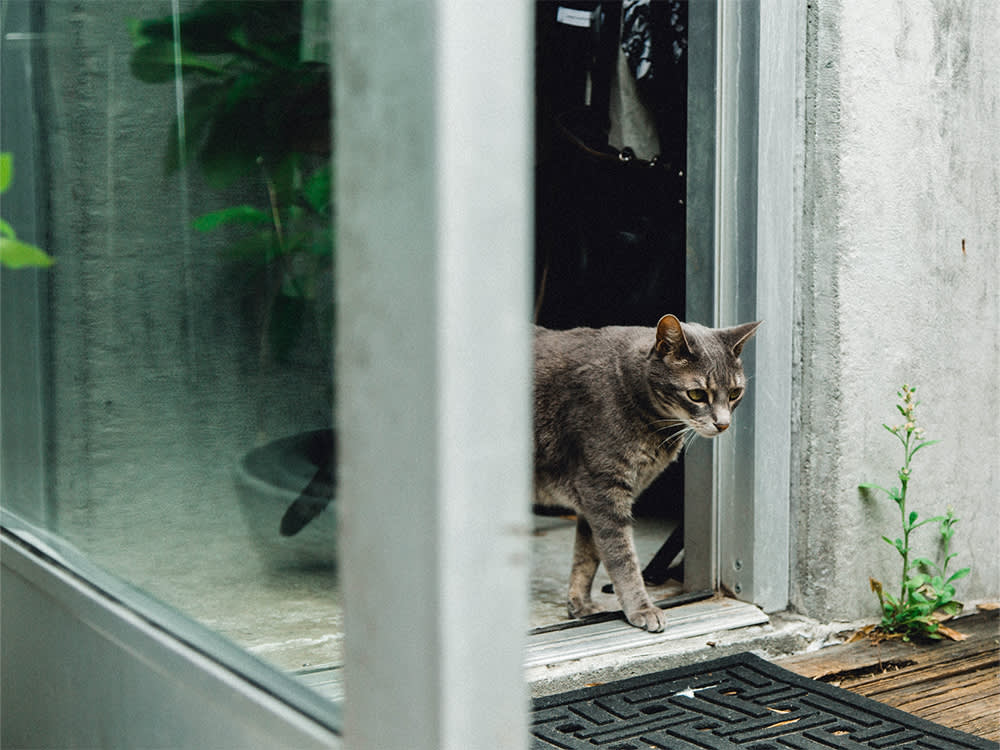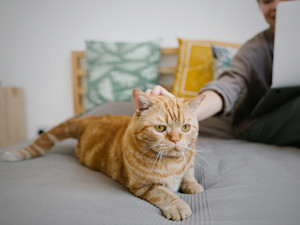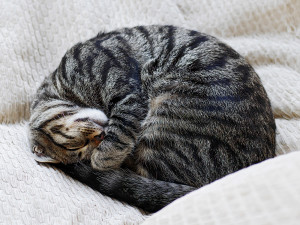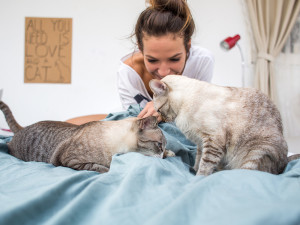Preventing Escape Artists: How to Keep Your Indoor Cat From Running Away
Your kitty’s an explorer. But if you want to keep their expeditions indoors, here‘s how

Share Article
We all know of many perfect pairings: Taylor Swift and revenge anthems, Thor and his hammer, or Yorkshire puddings and gravy, for example. They belong together and are at their best around each other. There are also pairs that absolutely do not go well together: Taylor Swift and Kanye West, Thor and Thanos, gravy and bananas... (sorry for that image).
One pairing that can be just as bad is cats and doors. Cats are little Houdinis who can sneak over, under, through, into, out of, and in between every kind of barrier devised by humankind. What they are capable of doing when it comes to getting away from us is a big deal, and that’s why many indoor cats run away once, twice, occasionally or even regularly.
If you’re wondering how to keep your indoor cat from running away, one profound truth to take in is that we have a much better chance of keeping them from running away if we focus on doing all we can to prevent them from wanting to run away in the first place.
Why do cats run away?
Cats escape all the time, providing opportunities for neighbours to bond over the search and even to cooperate in the retrieval, with one family providing a ladder and another family (usually mine) providing skilled tree-climbers for the final stage of the retrieval.
During these adventures, you may hear people asking, “Why do male cats run away?” and, “Why do female cats run away?” Cats of either sex run away for the adventure and the excitement, because it’s natural for them to roam a wider area than a house or garden, and perhaps because they love the outdoors. Some indoor cats run away because they find home to be a touch on the boring side, and they enjoy the opportunities for stimulation in the great wide world.
Can I train my cat to come when called?
Teaching your cat to come when called is a great idea, as it is a valuable skill for them to have. Teach them that they will get good things, such as treats, toys or a play session, when you say “come” and they follow the cue. The goal is to get your cat accustomed to the idea that if they come to you when called, they will be happy they did so because it is always a positive experience. That means you have to make them glad they came by providing something that is worth their while each time you give them this cue. Also, it is essential they are never sorry they came, which means not calling them to put them in their carrier, give them a bath, cut their nails, or to do anything else they won’t love.
Even once a cat is excellent at responding to the cue to come, I would not generally trust that their good recall will be enough to prevent them if they want to head outdoors and have an open door available to them. Even though training a cat to come when called is a wonderful skill, it’s not a complete solution to the issue of how to keep an indoor cat from running out the door.
How can I make my home escape-proof for my cat?
Barriers are one part of the ‘how to keep cats inside’ puzzle. By physically preventing escapes, you help your cat stay safe and stay with you. Gates are one useful tool, but you may need multiple gates stacked to cover a doorway to a height that can prevent cats, with their superior jumping ability, from getting away. Another idea is garden netting, which can keep cats from escaping gardens, balconies and catios. Such barriers remain in place to control cats’ movements even when you are not present.
Portable barriers are also useful and can be used when you open the door for your own entrances and exits. You can protect this open spot from becoming an escape route for even the most determined door darters with poster board or a large piece of foam. When you open the door, use these objects to block a cat’s access. The idea is not to frighten them, so you don’t need to approach or herd them. Just use the poster board or foam as a portable barrier to block their path to the outside. You can keep these in your car, in the porch, or outside your front door, so they are always ready for use when you enter or exit your house.
How can I prevent my indoor cat from running away?
Take advantage of multiple methods: preventing them from having the physical opportunity to escape, developing in them the habit of moving away from the door when it opens, and making the indoors fun and stimulating for them so they have less motivation to take off.
Preventing trouble is a powerful way to protect our cats, and trainers spend a lot of time teaching people ways to manage problematic situations. There’s often some resistance to this approach, perhaps because it feels like a cop-out to some people. It’s not. Prevention and management are wonderful tools that can keep your cat safe in situations that are more than they can handle. As cats become able to handle a broader range of situations, they are not needed as often, but these techniques are often useful forever – at least in some contexts.
Another way to prevent having a cat on the loose when you enter the house is to message someone who is at home so they can keep the cat away as you enter. They can play with the cat, pick them up (only if the cat doesn’t mind), entice them to go into another room, or give them some treats to keep them occupied until you are inside and the door is safely closed behind you. (Obviously, this only works if you live with other people and at least one of them is already home.)
If a cat’s response to the opening of the door is to go away from it and head somewhere else, they can’t dart out the door. You can train your cat to go away from, rather than in the direction of, an open door. Teach your cat to go to a specific place when anyone opens the door by making good things happen when they do. A great option is a cat tree or other high place (on a bookshelf or the top of the fridge) because many cats enjoy being elevated and naturally seek out such perches.
This method follows two fundamental principles of training: to teach your cat what you want them to do rather than what you don’t want them to do, and to teach them to perform a behaviour that is incompatible with the undesirable behaviour. Offer your cat a treat in the location you want them to go to whenever you open the door until going there becomes a habit. Make sure the treat is really, really good so your cat is highly motivated to go where you want them to go and really happy about it once they get there.
Another option that is especially effective with the most playful of cats is to toss them a toy they really like as you leave the house, and as you come back in the door. By throwing a toy away from the door each time it opens, you teach your cat to associate the door opening with fun, and you teach them the habit of running away from the door when it opens.
Habit is the result of training, and that means you want to develop the right habits that will keep your cat safe, and not any habits that make it more likely your cat will dash out the door when given the chance. One element of this is consistently greeting your cat and giving them attention only once the door is closed, you are well into the house, and neither of you is close to the door.
It’s common for people to ask, “Do cats run away if they are unhappy?” but perhaps the better question is, “Do cats run away if they are bored?” And the answer to that question is, sometimes yes. Many indoor cats are bored with the limited options for activity, adventure and fun offered at home, and they may make a run for it in order to add a little more spice to their life. This may be especially true for indoor cats who lived outside previously, or who were used to going outside in the past.
How can I make my cat more comfortable indoors?
Cats often seek to dash out because of all the stimulating stuff out there. The more satisfying their life is inside, the less eager they will be to head outside. With that in mind, increasing the options for mental and physical stimulation can help keep cats from attempting to escape. Here are the things to add to your home, in order of importance, to make their life indoors as appealing as possible, so they have less motivation to wander off.
Food puzzles keep cats occupied, requiring them to use their minds, paws and mouths in creative ways to access the treats inside. Whether they must reach their paws in to get the food, roll a treat ball around until bits of tasty rewards fall out, open compartments, push a button, or flip a lid to reach treats, puzzle toys are good for cats. They offer cats a lot of ways to keep their brains and their bodies occupied doing interesting things.
More vertical space – in the form of cat trees or other elevated spots – offers your cat options for exploration, as do add-on components that allow cats to go through tunnels, leap to varied perches, or access bookcases, shelves, or any other high spot. Cardboard boxes can be tunnels or forts for cats and provide quite a lot of entertainment, even on the ground.
New toys can provide a lot of fun, as can increasing the amount of time you spend using them to play with your cat. Wand toys that are interactive are especially engaging for most cats. Toys cats can roll around and bat at allow them to play independently, as do those with tracks containing balls that can be pushed around endlessly, so they can have fun even when you’re gone.
Frequently asked questions
How can I make my home escape-proof for my cat?
Barriers such as gates, boards and garden netting are key tools in escape-proofing your home.
What should I do if my cat does escape?
Search nearby and ask neighbours to help because most lost cats are found hiding close to home. Put food and water in a safe area and monitor the spot with a motion-sensitive camera.
How can I prevent my indoor cat from becoming anxious or bored, leading to escape attempts?
Enrichment with catios, toys, food puzzles, playtime and vertical climbing options all help keep cats happy and engaged.
Should I consider spaying or neutering my cat to reduce the desire to roam?
Spaying and neutering may make some cats less likely to wander away from your home and around the neighbourhood, but it does not have this effect on all cats.
References

Karen B. London, PhD, CAAB, CPDT-KA
Karen B. London, Ph.D., is a Certified Applied Animal Behaviorist and Certified Professional Dog Trainer who specializes in working with dogs with serious behavioral issues, including aggression, and has also trained other animals including cats, birds, snakes, and insects.
Related articles
Do Cats Get Jealous?
Is there a green-eyed monster hiding in that adorable ball of fluff?

Uncovered Secrets: Why Cats Don’t Always Cover Their Poo
And how you can encourage them to cover up after doing their business

6 Common Health Concerns in Senior Cats
How to spot and how to treat them

How Many Cat Naps Is Too Many?
A very sleepy kitty isn’t usually a problem, but watch out for these signs of medical distress

Dogs Rule, Cats Drool, Right?
Sometimes it works the other way round – here’s why your cat is drooling

What Your Cat’s Sexy ‘Slow Blink’ Actually Means
Cat behaviourist Cristin Tamburo on how to read cat eyes




